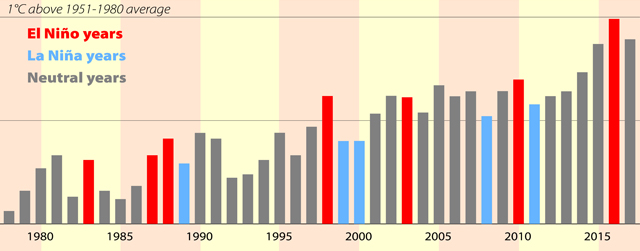Josh Frydenberg protests that the Turnbull government is on track to achieve climate goals. Unfortunately that’s not the same as cutting emissions.

Annual average global surface temperatures over the past 40 years, derived from NASA and Copernicus data.
If you’re feeling relieved that the average temperature in 2017 around the world and in Australia was slightly lower than that of the record-breaking year of 2016, stop right now.
There is nothing in the latest temperature data to feel good about. While 2016 experienced an El Niño weather event, which tends to push global temperatures markedly higher, 2017 didn’t.
Even so, the European Union’s climate-monitoring service Copernicus says that last year was still warmer than 2015 and 2014 and all other years on the record going back to the mid-1800s. It was also half a degree warmer than the 1981-2010 average and 1.2C warmer than in the 1700s.
The Bureau of Meteorology announced last month that the world was in a weak La Niña phase, which may help ensure 2018 remains below 2016. But that’s little comfort.
In Australia, the Bureau said last week, 2017 continued the trend of warmer-than-average years, coming in third hottest behind 2016 and 2015, both of which had been affected by a strong El Niño.
Nobody could be surprised by any of this. Science revealed 150 years ago that carbon dioxide retains heat energy. It’s 70 years since we knew that carbon dioxide levels in the air were rising, and strong evidence that this was causing global warming surfaced in the 1980s.
In the 25 years since nations resolved to act in 1992, the level of atmospheric carbon dioxide has continued to climb ever more rapidly. It is now well clear of 400 parts per million everywhere in the world – 45 per cent higher than in pre-industrial times.
Some nations, notably European ones, are performing better than others, but China still depends heavily on coal to power its growth and Donald Trump and the US Congress continue to behave as if nothing is happening. Small successes are being dwarfed by monumental failure.
All nations are culpable, but as the only nation to ditch carbon pricing, Australia is especially so. We replaced a promising but deficient pricing scheme (it didn’t tackle transport) with a mish-mash of ineffectual measures that skirt around the central problem, fossil-fuel emissions.
In the Hobart Mercury on 2 January, environment minister Josh Frydenberg took issue with my negative comments in December about his government’s performance on climate, writing that I overlooked “significant action”.
He wrote that the government would “easily surpass” its 2020 emission target and had a much better “emissions outlook” than when Labor was in power. He said the Clean Energy Finance Corporation and the Australian Renewable Energy Agency had lowered the cost of innovation.
While both those agencies are doing well, there’s a whiff of hypocrisy in underpinning an argument with such Labor initiatives without mentioning that his own government sought to abolish them. And surpassing modest targets using highly-uncertain land-use data is nothing to be proud of.
Frydenberg said I had belittled and “ridiculed” key measures of his government. I admit to angry words, but my message was that the schemes’ emissions-cutting capacity was overblown. Ignoring transport emissions, for instance, is surely a shortcoming as it was under Labor’s carbon price.
The failure of existing measures to bring down fossil-fuel emissions is on clear display in the government’s own data. The passage of time means new measures need be tougher than what previously applied. My complaint is that they’re actually weaker.
Frydenberg referred to my “latest polemic against the Turnbull government”. This says a lot about the parlous state of climate policy in the government. Branding criticism as a polemic apparently gives licence to ignore the substance of the criticism, which gets us nowhere.
This should not be so personal. The PM and his environment minister may mean well, but they have fallen captive to a minority sentiment in their party that sees global warming as nothing more than politics, a leftist plot. Such a sentiment precludes rational discussion of climate issues.
It’s a disease that has persisted here and elsewhere in the developed world, led by perhaps the most ideologically-driven, least informed president ever to sit in the Oval Office.
With gung-ho Environmental Protection Agency head Scott Pruitt and Interior Secretary Ryan Zinke as his attack dogs, Donald Trump has presided over the systematic dismantling of previous administrations’ climate measures, while also sacking or silencing government scientists.
So far successive Coalition governments have not rejected wholesale the advice of professional scientists and other specialists, although Tony Abbott as PM dipped a toe in this murky water.
In light of its repeated failure to respond to scientists’ pleas to put teeth into climate measures – not to mention Turnbull’s demotion of science to a non-cabinet portfolio during the Christmas rush (funny, that) – it’s reasonable to conclude that the government is putting ideology ahead of reality.
The world has wasted precious time playing politics with climate change. Now we are reaping the miserable consequences.
